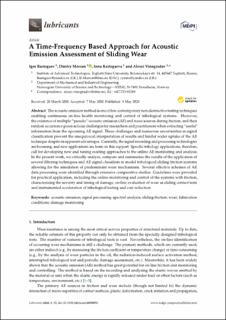| dc.contributor.author | Rasteagev, Igor | |
| dc.contributor.author | Merson, Dmitry | |
| dc.contributor.author | Rastegaeva, Inna | |
| dc.contributor.author | Vinogradov, Alexey | |
| dc.date.accessioned | 2021-01-18T13:22:07Z | |
| dc.date.available | 2021-01-18T13:22:07Z | |
| dc.date.created | 2021-01-17T12:21:07Z | |
| dc.date.issued | 2020 | |
| dc.identifier.citation | Lubricants. 2020, 8 (5), 52-76. | en_US |
| dc.identifier.issn | 2075-4442 | |
| dc.identifier.uri | https://hdl.handle.net/11250/2723512 | |
| dc.description.abstract | The acoustic emission method is one of few contemporary non-destructive testing techniques enabling continuous on-line health monitoring and control of tribological systems. However, the existence of multiple “pseudo”-acoustic emission (AE) and noise sources during friction, and their random occurrence poses serious challenges for researchers and practitioners when extracting “useful” information from the upcoming AE signal. These challenges and numerous uncertainties in signal classification prevent the unequivocal interpretation of results and hinder wider uptake of the AE technique despite its apparent advantages. Currently, the signal recording and processing technologies are booming, and new applications are born on this support. Specific tribology applications, therefore, call for developing new and tuning existing approaches to the online AE monitoring and analysis. In the present work, we critically analyze, compare and summarize the results of the application of several filtering techniques and AE signal classifiers in model tribological sliding friction systems allowing for the simulation of predominant wear mechanisms. Several effective schemes of AE data processing were identified through extensive comparative studies. Guidelines were provided for practical application, including the online monitoring and control of the systems with friction, characterizing the severity and timing of damage, on-line evaluation of wear as sliding contact tests and instrumented acceleration of tribological testing and cost reduction. | en_US |
| dc.language.iso | eng | en_US |
| dc.publisher | MDPI | en_US |
| dc.rights | Navngivelse 4.0 Internasjonal | * |
| dc.rights.uri | http://creativecommons.org/licenses/by/4.0/deed.no | * |
| dc.title | A Time-Frequency Based Approach for Acoustic Emission Assessment of Sliding Wear | en_US |
| dc.type | Peer reviewed | en_US |
| dc.type | Journal article | en_US |
| dc.description.version | publishedVersion | en_US |
| dc.source.pagenumber | 52-76 | en_US |
| dc.source.volume | 8 | en_US |
| dc.source.journal | Lubricants | en_US |
| dc.source.issue | 5 | en_US |
| dc.identifier.doi | 10.3390/lubricants8050052 | |
| dc.identifier.cristin | 1872635 | |
| dc.description.localcode | © 2020 by the author. Licensee MDPI, Basel, Switzerland. This article is an open access article distributed under the terms and conditions of the Creative Commons Attribution (CC BY) license (http://creativecommons.org/licenses/by/4.0/). | en_US |
| cristin.ispublished | true | |
| cristin.fulltext | original | |
| cristin.qualitycode | 1 | |

